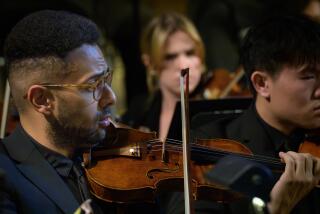EAR Unit Celebrates the Inventions of Composers
- Share via
The California EAR Unit called its program of American music Monday at the Los Angeles County Museum of Art “In the Spirit of the Musical Inventor.” One could, of course, title most programs that way. Music is an art that has progressed historically by inventions, be they new technologies, new sounds, new structures or new ways of hearing. But only in the American century has it actually been considered an act of praise to call a composer an inventor.
For its appearance at the Monday Evening Concerts this season, the EAR Unit looked at two slices of this inventive American musical century: the period between 1928 and 1939 and the present. The composers from a half century ago were Virgil Thomson, Lou Harrison, Ruth Crawford and Henry Cowell. All were radicals, participants in the modernist spirit of their times. Thomson was most inventive when he worked with inventive words, especially Gertrude Stein’s. Crawford’s inventions were intellectual and abstract, dealing with tone and form. Cowell was a hands-on inventor, making instruments and restlessly seizing musical cultures East and West, and Harrison followed his lead.
Yet it seemed the EAR Unit selected the four short pieces on the first half of the program as much for amiability as innovation. Thomson’s Piano Sonata No. 2, arranged for small chamber ensemble by Ivar Mikhashoff, is simple but full of quirks, disarming turns of phrases. It sounded weird, however, played as accompanied to a silent film by Lawrence Brose of ghostly images of the composer filmed in 1990, shortly before he died.
Harrison’s 10-minute First Concerto for Flute and Percussion, handsomely played by soloist Dorothy Stone, is an early example of Harrison’s pull toward Asia. Crawford’s Piano Preludes, 6-9, played sumptuously by Lorna Eder, are more urban and Western. Cowell’s “Toccanta,” written for flute, violin, cello and piano in 1938 but only now receiving its first local performance, is another example of Cowell’s gracious syntheses: Bachian counterpoint, folk tunes, sweet harmonies, declamatory statements, melodic ornaments imported from Asia are all made to feel at home here.
The recent works, after intermission, were equally spunky and good-natured, their inventions being enthusiastic applications of whatever is at hand. Michael Torke’s “Telephone Book” is a new extension of his 1985 hit--and EAR Unit standard--”The Yellow Pages,” with two more musical directories, blue and white. Torke’s inventions have been pragmatic designs, the application of formal rhythmic devices to youthful and engaging pop melodies. Repetitious yet fresh and charged, these pieces seem to leap forth like an electric current, a telephone book come to life.
After the tidy playing of the first half, the Torke, though, sounded something of a mess, intonation and balances rough, the EAR Unit’s often alluring edge here becomes sloppiness. But not so in Rand Steiger’s new “Frame(s),” a small concerto written to show off percussionist Amy Knowles. A chic, keen performer, she has needed a vehicle like this for years. Steiger, the EAR Unit’s conductor, kept Knowles in perpetual motion with mallets flying, while the other instruments remained in stubborn, slow accompaniment. In the middle section, she used various sound-producing devises to shake the ensemble into improvised actions. Throughout, lights on an electronic console twinkled as they amplified the sound and sent it, in surround mode, around the theater. That was Steiger’s invention, and it was a lively one.
More to Read
The biggest entertainment stories
Get our big stories about Hollywood, film, television, music, arts, culture and more right in your inbox as soon as they publish.
You may occasionally receive promotional content from the Los Angeles Times.











